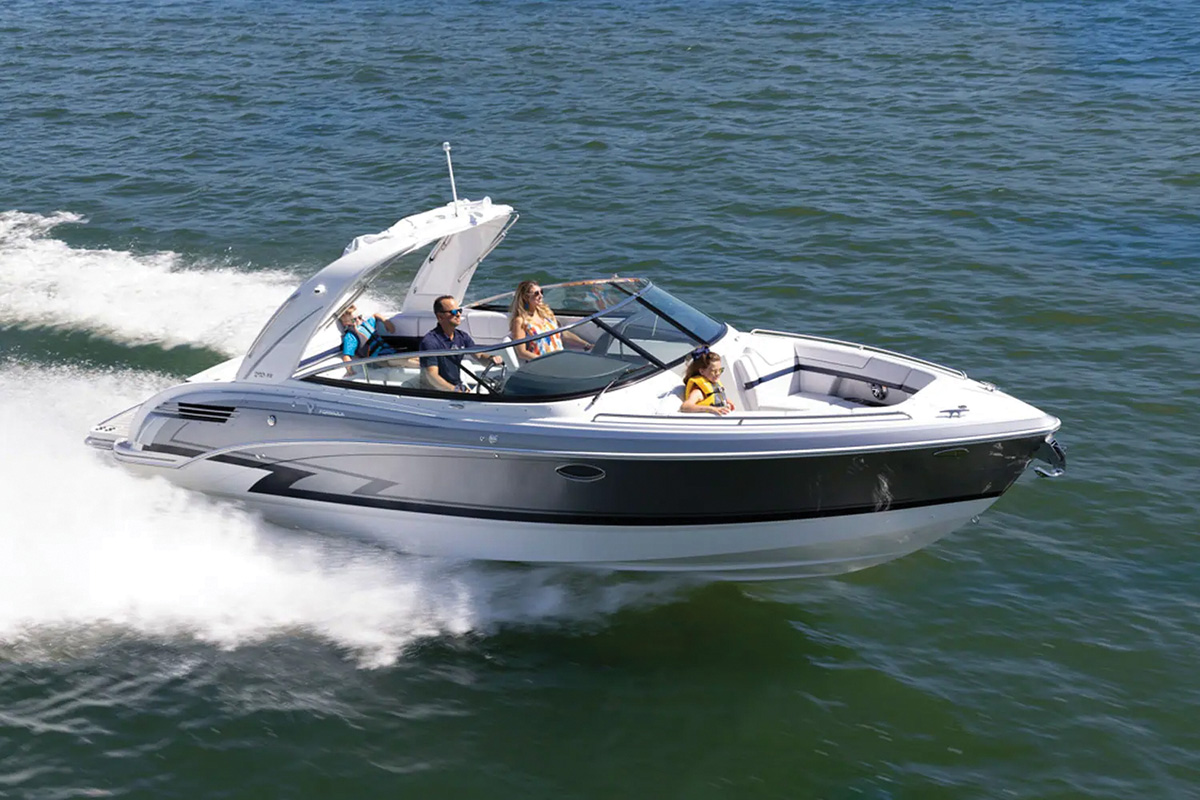By Dusty Miller
One of the many benefits of a driving boat powered by twin engines is the ability to effectively maneuver at low speeds without touching the wheel. While this is often the case with twin direct drive or V-drive powered models, it’s often not the case with models powered by twin IO engines.
The propellers of an IO engine are not under the boat. They are positioned four or five feet abaft of the transom. Since they are so far from the turning centre of the boat, the turning force is minimal. You can put one throttle in forward and the other in reverse and just sit there with the engines grumbling away. Eventually it will start to turn, but it will just creep around and isn’t efficient or effective enough.
The best way to handle a twin IO at low speeds is to use one engine at a time and steer with the wheel. For example, if you’re headed down a slipway in a crosswind, place the throttle on the downwind side in gear. That way, the turning force it does provide pushes against the force of the wind and helps maintain a straight line. When turning, use the throttle on the outside of the turn to help bring the boat around. So, when turning to the port, use the starboard engine and vice-versa.
Using the wheel with an IO can also be a little tricky at low speeds. First of all, only turn the wheel when both engines are in neutral. If the wheel is turned when the boat is in gear, the stern will swing out farther than expected (and you’ll have to correct it to go the other way). If the shifter is left in gear and the wheel is turned the other way, the boat will swing too far again and end up zigzagging on the edge of being out of control. Remember you don’t have to turn the wheel too hard to change direction. The only time to crank the wheel with IO engine is when you want to make very abrupt turns. In most cases, a short turn of the wheel is sufficient.
With an IO, turning the wheel doesn’t just redirect the flow of water from the prop like a rudder. The wheel actually changes the direction of the propeller and there’s a lot more force with a lot more leverage since the props are so far from the turning point of the boat.
Practice makes perfect, so here are a couple of exercises to try. First of all, secure the boat to a strong dock using three or four fenders and four lines: one each fore and aft and two spring lines. Now, start both engines and let them warm up long enough so they won’t stall when you put them in gear. Make sure the wheel is centred and put the outside engine in gear. As soon as you feel the boat move, take it out of gear again. Now do it with the other side. Move the shifter in gear and as soon as you feel the prop engage, go back to neutral right away. I call this touch-in, touch-out and it’s how to keep the boat under control at low speeds. Only engage the propeller long enough to get the boat turning – not moving forward or reverse – but turning. Also remember, when you engage the side that’s farther from the dock it will push the boat toward the dock and the inside engine will push it away.
Now, take your boat out into open water and practice turning in its own length. This is easy. To turn to port, turn the wheel to port (with both engines in neutral, remember). Whether you’re proceeding forward or reverse, you always turn the wheel in the direction you want to go. With the wheel to port, engage the starboard shifter. As soon as you hear the transmission mesh, go back to neutral. Now turn the wheel to starboard, and put the port side shifter in reverse. Touch-in, touch-out. You’ll notice the bow will start to turn. To keep turning, repeat the procedure. The boat will literally turn without proceeding either forward or reverse. To stop the turn to port, turn the wheel to starboard and put the starboard side in forward. The boat will stop.
Twin IO engines won’t offer the same handling characteristics of a twin direct drive. But, properly used with the wheel they will provide finer control than a single IO. With a little practice, you’ll make your boat dance.
Keyword : Better boat handling, boat engines, boat handling, Boating, inboard engines, twin engines, twin IO Better boat handling, boat engines, boat handling, Boating, inboard engines, twin engines, twin IO
